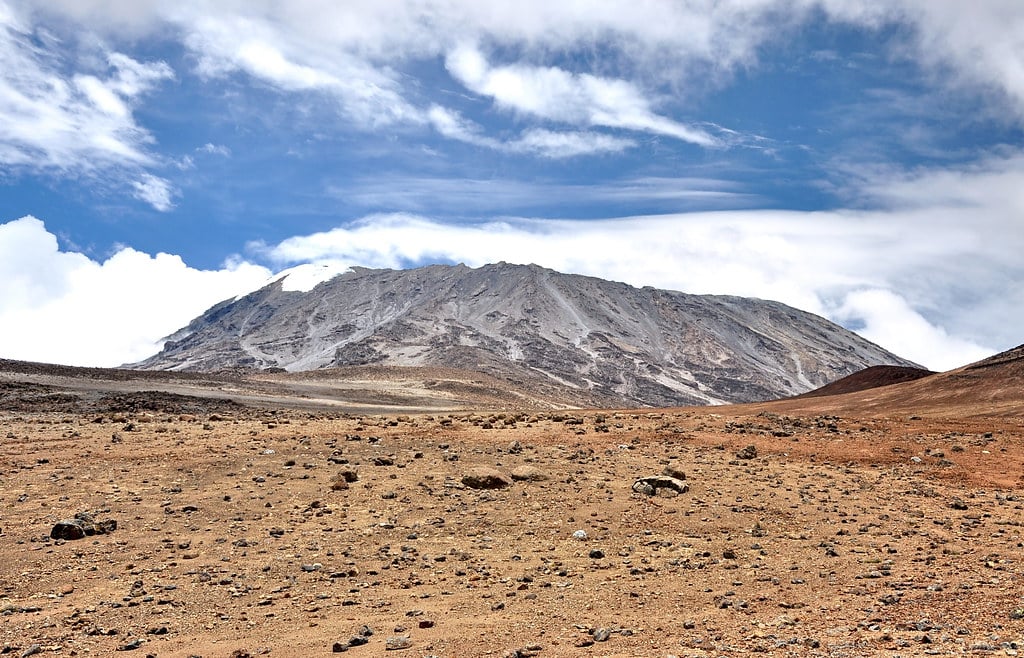Mount Kilimanjaro Ecological Zones
Mount Kilimanjaro Ecological zones encompasses five well-defined climate zones: Cultivation, Forest, Moorland, Alpine Desert, and Arctic. In the following sections, we will explore the distinctive characteristics of each zone. As you ascend the tallest mountain in Africa, you will traverse through each of these climatic regions.

Kilimanjaro's five Ecological zones
Let’s explore each of these distinct ecosystems in depth:
1. Cultivation Zone:
Alt. Range: 2,600 to 6,000 ft (792 to 1,800 m)
Temperature Range: Days: 70-90 F / 21-32 C
Nights: 40-60 F /4-15 C
As you approach Kilimanjaro’s entrance, you will traverse through the cultivation zone, offering views of farms and villages. Numerous porters, cooks, and guides, along with their families, reside in these villages.
This zone experiences the highest annual rainfall and is characterized by numerous rivers fed by the glacial melt from Mount Kilimanjaro’s summit. These favorable conditions make the land well-suited for agriculture. Many small villages thrive in this area, engaging in the cultivation of crops such as coffee, avocados, mangos, and bananas.

2. Rain Forest Zone:
Alt. Range: 6,000 to 9,200 ft (1,800 to 2,800 m)
Temperature Range: Days: 70-90 F / 21-32 C
Nights: 40-60 F /4-15 C
Regardless of the route you select with Kopa Tours, your initial day of hiking will lead you through Mount Kilimanjaro’s rainforest zone. It’s advisable to equip yourself with waterproof clothing, given the predictable wet conditions in this zone. The moderate temperatures within the rainforest make this segment of the hike quite pleasant.
Traversing through dense, luxuriant forests, you’ll encounter a spectrum of green hues. The thick tree canopy often obscures the sky from view. What’s not uncommon, however, is the chance of spotting wildlife—among all the zones, the rainforest is where wildlife sightings are most likely. Keep a keen eye out for Blue monkeys and Colobus monkeys during your journey.

3. Heath and Moorland Zone:
Alt. Range: 9,200 to 11,000 ft (2,800 to 3,350 m)
Temperature Range: Days: 50-80 F / 10-27 C
Nights: 30-60 F /(-1)-15 C
Upon entering the heath and moorland zone, the forest seemingly comes to an abrupt halt, revealing breathtaking views. Marked by scrubby shrubs, towering giant heathers, and tufts of grass resembling the Scottish Highlands, the lower part of this zone offers a distinctive landscape.
As you ascend, encountering a drop in average temperatures, you’ll observe the emergence of giant lobelias and senecios. These plants have evolved unique features to thrive amidst the drastic temperature fluctuations. Senecios, growing taller, retain their dead leaves, forming a fur-like insulation around the trunk. Lobelias, on the other hand, close their leaves at night, enveloping their central core for warmth.
Wildlife is sparse in this zone, with occasional reports of eland, small antelope, and elephants passing through. Small rodents find shelter in minute caves carved out of volcanic rock. Keep a vigilant eye for the graceful flight of soaring raptors in this unique and tranquil environment.

4. Highland Alpine Desert:
Alt. Range: 13,200 to 16,500 ft (4,020 to 5,030 m)
Temperature Range: Days: Days: 10-60 F / (-12) -15 C
Nights:10-40 F /(-12)-4 C
Your trek progresses into the Alpine Desert zone, where the designation ‘desert’ aptly captures the essence of this climatic region. Compared to other zones, plant life is sparse, and understandably so. Survival here demands endurance through subzero temperatures at night and intense sunlight during the day. The Alpine Desert zone is marked by a landscape adorned with volcanic rocks in various shapes and sizes, providing visible evidence of Kilimanjaro’s dynamic geological history.
While navigating the Alpine Desert Zone, you’ll be in close proximity to Kibo’s peak, offering panoramic views of its glaciers and steep ledges. It’s crucial to pack warm clothing for this segment of the trek, as temperatures are known to plummet well below freezing.

5. Arctic Summit zone:
Alt. Range: 16,500 to 19,340 ft (5,030 to 5,895 m)
Temperature Range: Days: 10-40 F / (-12) -4 C
Nights: -15-20 F /(-26)-(-7) C
Embarking on the final ascent to Mount Kilimanjaro’s summit, you’ll commence your journey from either Barafu Camp or Kibo Hut Camp under the veil of night. Negotiating through scree slopes, a blend of loose dirt and gravel, you’ll steadily progress toward Uhuru Peak. The advantage of a nighttime climb lies in the frost, consolidating the scree for a more stable ascent. Following a zigzagging trail, you’ll ascend to the rim, reaching either Stella Point or Gilman’s Point, before making the ultimate push to Uhuru Peak. Upon arrival, the Uhuru Peak sign awaits, providing a moment to capture photos and commemorate your remarkable accomplishment.
This zone is notorious for its harsh cold and exposure to environmental elements. Equip yourself with warm, weatherproof attire to combat the challenging conditions. Hand warmers can be a valuable addition, especially if you rely on hiking poles. As you conquer this final stretch, you’ll stand at the summit of Africa, marking the culmination of your Kilimanjaro adventure.
